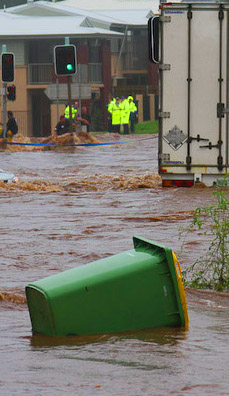Floods should be factored in
 Experts have slammed building regulations that ignore major flood zones.
Experts have slammed building regulations that ignore major flood zones.
Authorities have this week issued flooding risk and evacuation warnings for many areas in coastal NSW as rain continues to lash the east coast of Australia.
Environmental engineer Dr Tom Hubble from the University of Sydney says local geography is contributing to the large volume of floodwater flowing through the Hawkesbury-Nepean River.
The shape of the land means it is susceptible to the so-called ‘Bathtub Effect’.
“This ‘bathtub’ is a low-lying natural basin-like depression in the landscape that has formed very slowly over the past 100 million years due to plate tectonic processes associated with the formation of the Tasman Sea,” Dr Hubble says.
“The ‘Bathtub’ is floored by layers of mudstone rock that have been folded into a basin-shaped depression.
“This geological structure is surrounded by the steep terrain and deep gorges eroded into the Sydney sandstones of the Blue Mountains and the Hawkesbury River.
“At the transition between the bathtub’s mudstones and the gorges of the surrounding high-standing sandstone country the Hawkesbury-Nepean River’s channel narrows in width.
“This creates a pinch-point constriction that partially blocks the river channel and impedes the river flow.
“In the same way that a bathplug sitting halfway over a plughole slows down the draining of a bath, this natural pinch-point structure has backed-up floodwaters into the ‘Bathtub’. "
Dr Margaret Cook - a History Lecturer at the University of the Sunshine Coast (USC) - says there is a fairly logical reason why so many people find themselves living in flood-prone areas.
“Historically, cities throughout the world have been built on floodplains as they provide a water source, transportation, and in earlier times, fuel and effluent dumps,” Dr Cook says.
“Riverside land is an attractive place to build homes.”
Australia has two dominant hydrological cycles - flood and drought.
“During floods we are made aware of our flood vulnerability,” Dr Cook says.
“Floodwaters expose the floodplain, land that seems incapable of flooding in drought. Dry years confuse our environmental knowledge as floods are relegated to memory.
“We develop a myth that they won’t happen again. We confuse the idea that a one in 100-year flood means it won’t happen again for another 100 years – not what this means. We build dams or engineering structures that convince us they won’t happen again.”
Dr Cook says that with decades often elapsing between floods, newcomers to the region do not have the knowledge of previous floods to help them understand the risk and the need to evacuate.
“Knowledge and memory saves lives and property. Those who have experienced previous floods know to evacuate,” she said.
Dr Dorina Pojani, an expert in urban planning at the University of Queensland, says people should simply not be allowed to live in such risky areas.
“Residential housing should not be permitted in areas at risk of flooding,” Dr Pojani says.
“Flood maps should be taken into consideration seriously rather than in a cursory way.
“It’s the same with fires: some of the catastrophic damage from past bushfire seasons could have been avoided had residential construction not expanded in places which should have remained ‘natural’.
“As a society, we have been very arrogant to think that we can dominate and subjugate nature without suffering any consequences.”
Dr Pojani says that economic mandates should not be allowed to trump ecological considerations.
“The immediate problem is what to do with the many houses that have already been built in the flooded areas.
“In some cases, it may be feasible to relocate to infill developments within the existing urban footprint. In other cases, it may be more realistic to implement measures to reduce flood impacts on this housing.
“Finally, we may have to embrace the architectural concepts of water-based cultures, e.g., in Southeast Asia, and adopt floating housing and housing on stilts, which can cope better with floods.”
Professor Jamie Pittock - Professor at the Fenner School of Environment and Society at The Australian National University - says that the impact of the floods in the Hawkesbury-Nepean valley “is due to poor governance rather than any act of God”.
“Successive state governments have failed to address the 5,000 homes built below the 1:100 year flood line,” Prof Pittock says.
“The NSW Government’s proposed ‘silver bullet’ solution of raising the Warragamba Dam to control floods is dangerous.
“International experience is that such infrastructure encourages more downstream development that is then inundated when the inevitable big flood exceeds design limits. “Further, the dam will not regulate floodwaters from downstream tributaries like the Grose River and South Creek.
“The NSW Government should stop plans for 134,000 people to move onto the floodplain by 2050. It should begin long term programs to help the most flood-prone residents relocate to safe sites. Restoring the floodplain to give the river room to flood more safely can boost opportunities for agriculture, recreation and nature conservation.”








 Print
Print